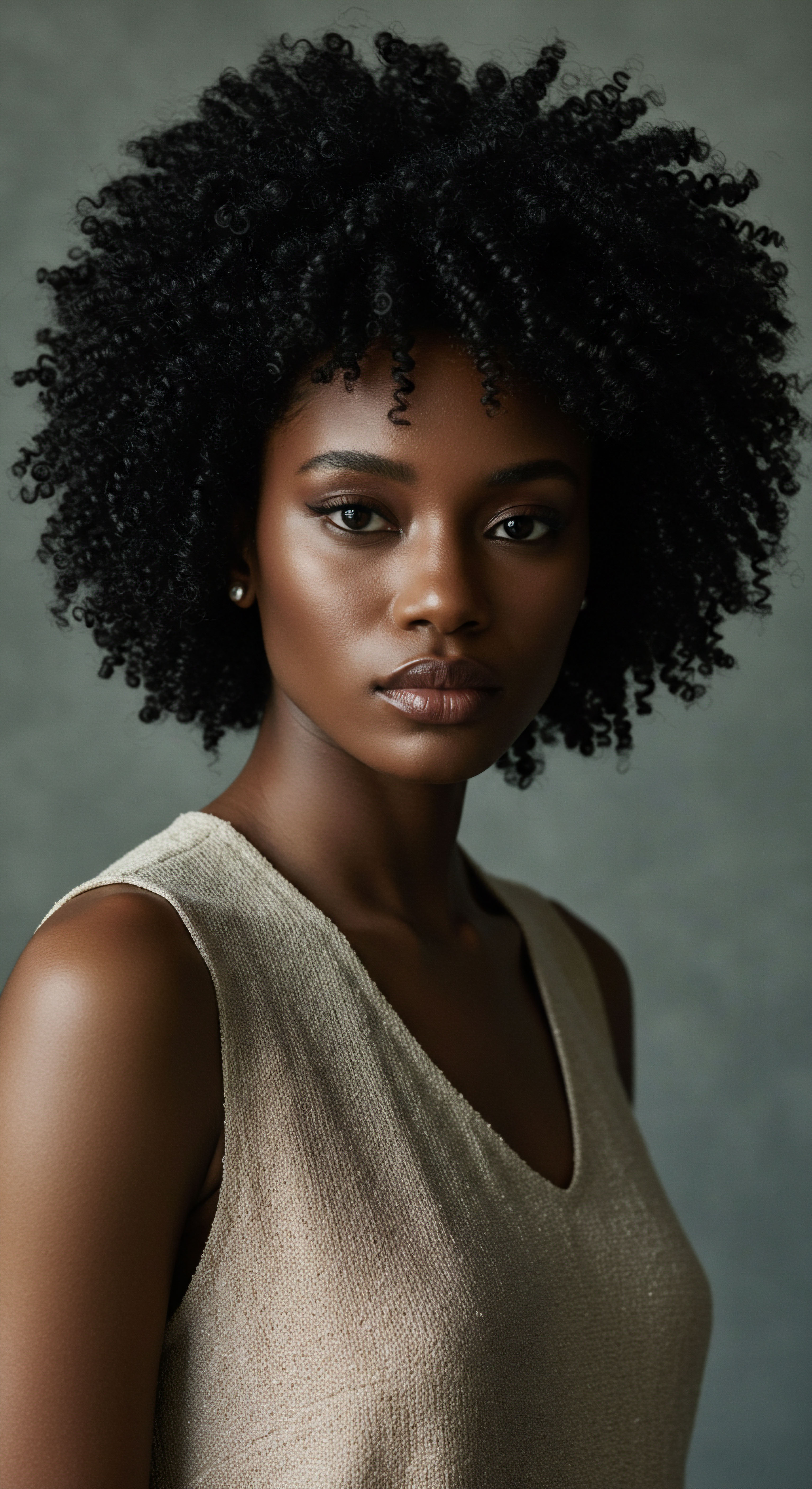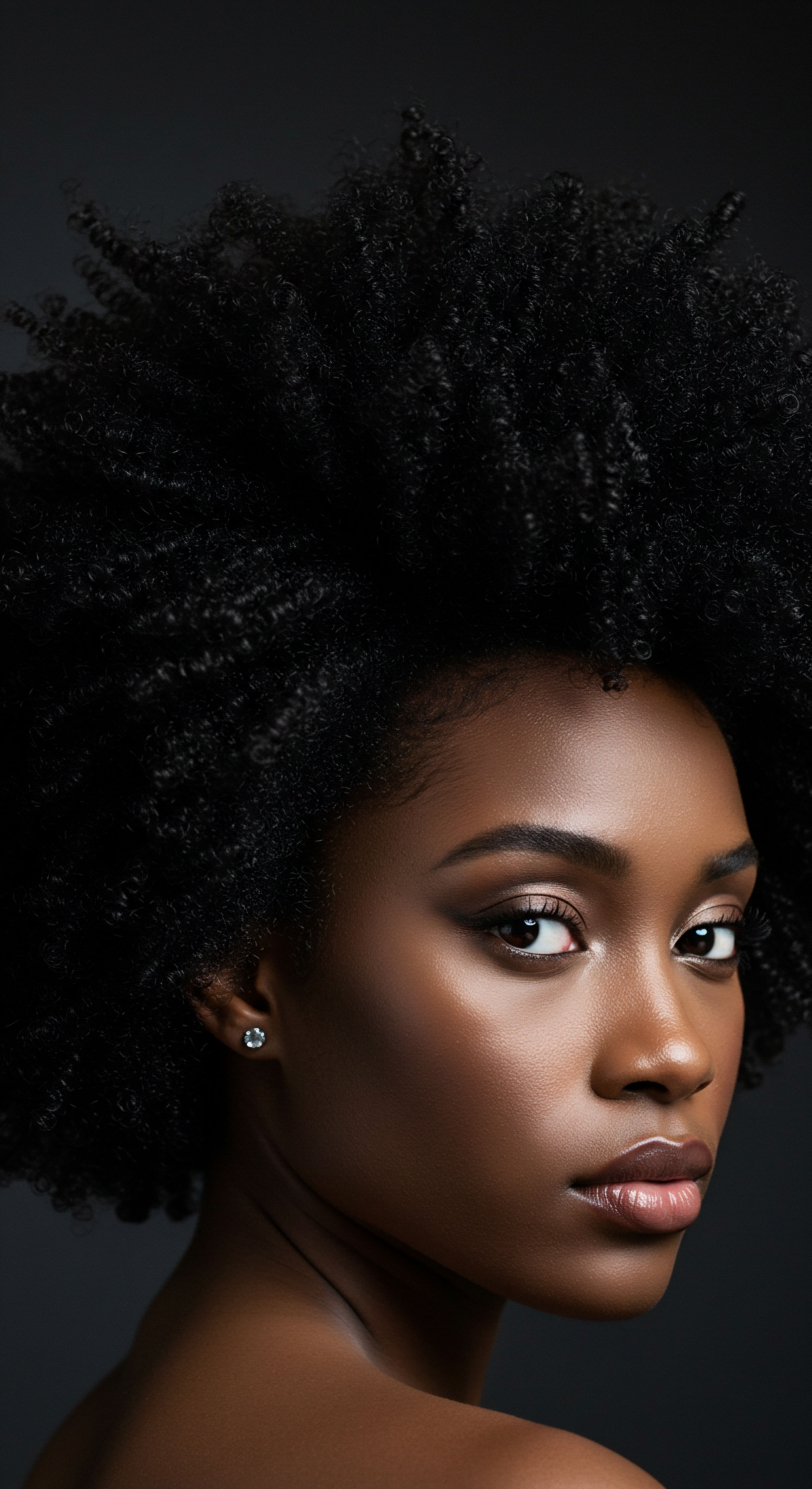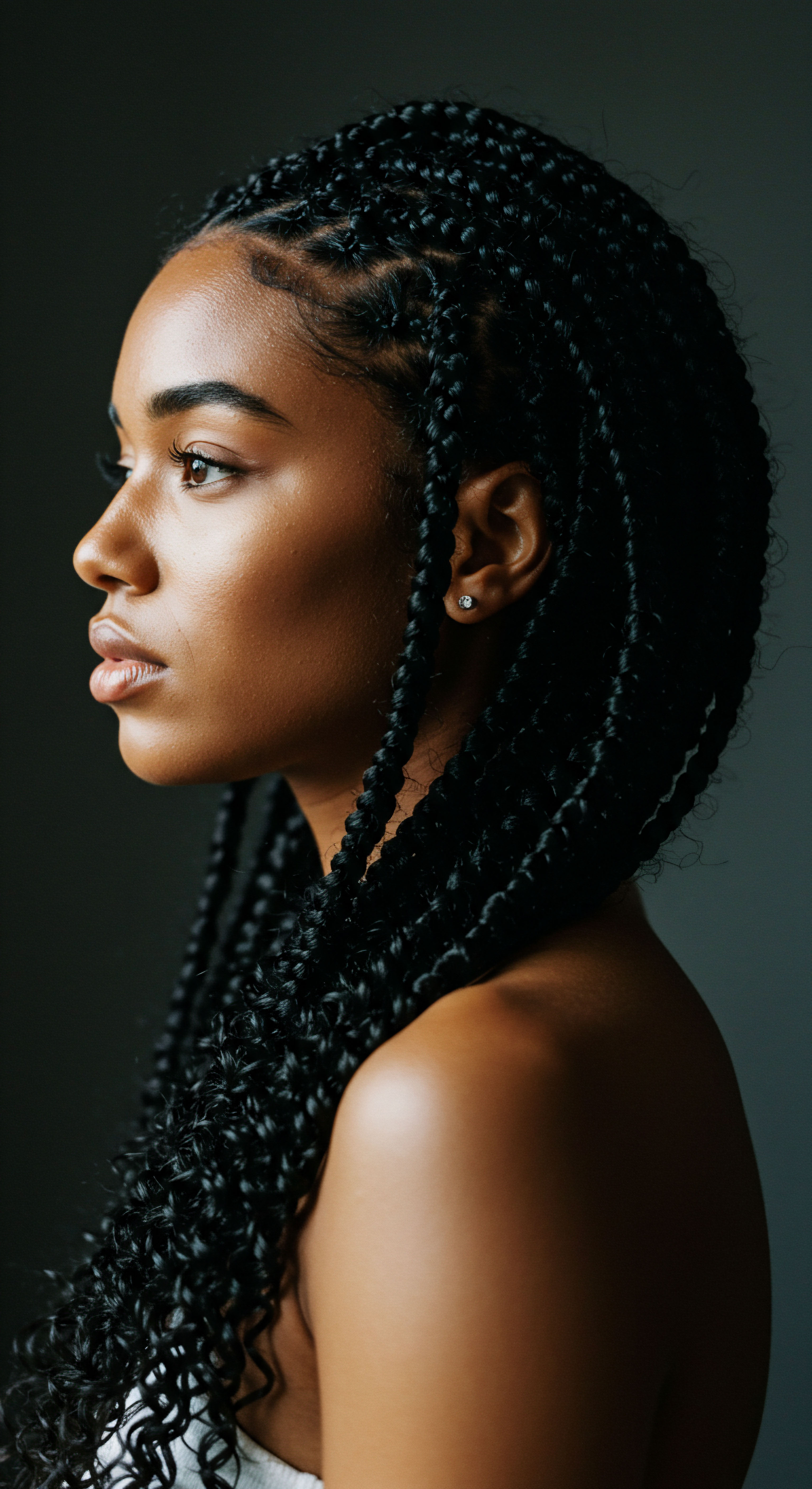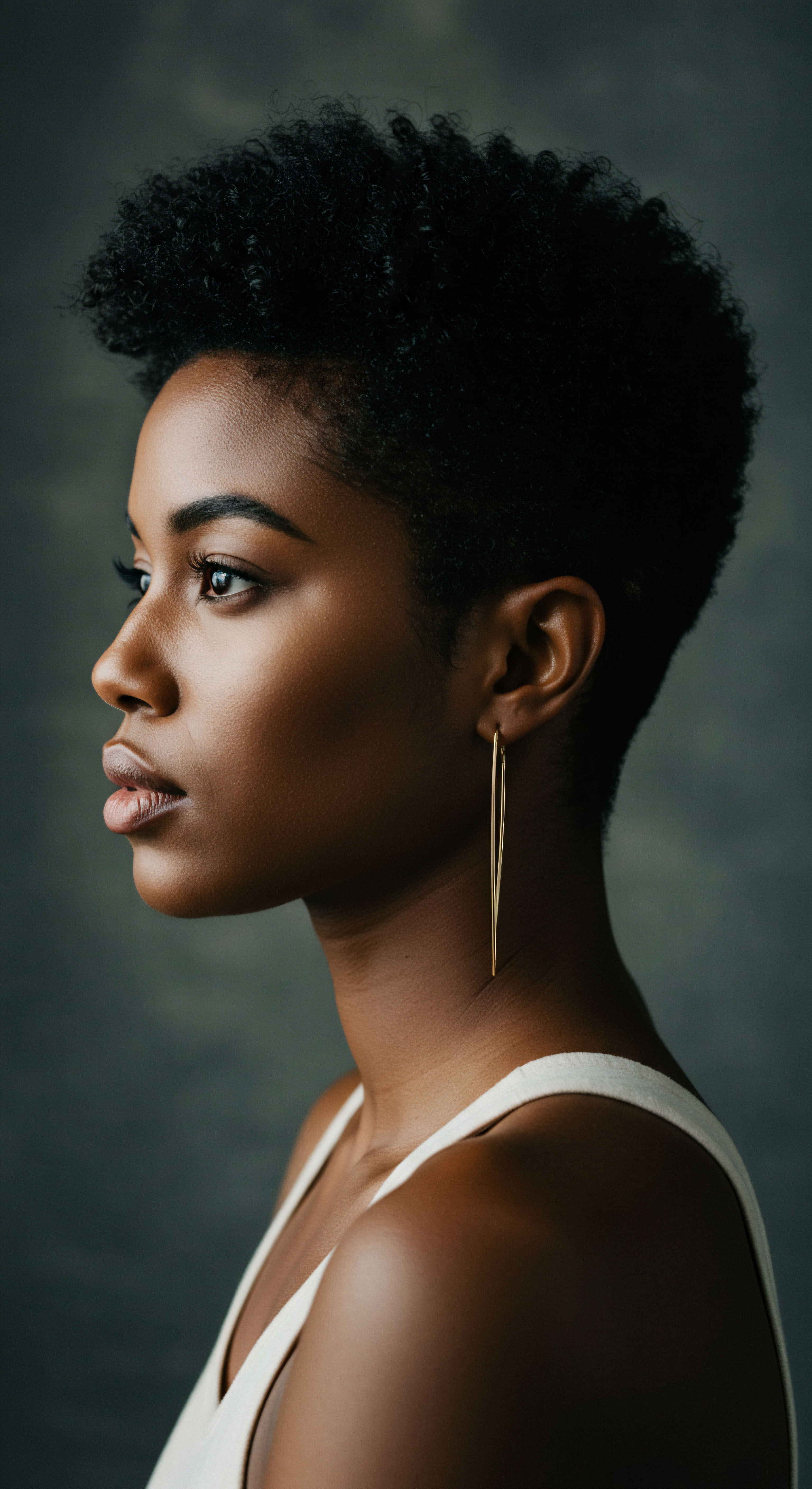
Fundamentals
Natural Hair Equity stands as a radiant concept, beckoning us to a deeper comprehension of hair, particularly textured hair, and its rightful place in our world. At its heart, this concept is a profound call for fairness and unbiased recognition of all hair types, celebrating their inherent beauty and structural integrity without prejudice. It represents a statement, a clear designation, that every coil, curl, and wave possesses intrinsic worth, deserving of respect and understanding. This initial explanation helps to clarify the basic meaning, inviting those new to the discussion of textured hair care and its broader societal implications to approach the topic with an open heart.
For many, especially within Black and mixed-race communities, hair is far more than mere strands; it embodies a living chronicle of heritage, a tangible link to ancestral knowledge, and a vibrant expression of identity. The idea of Natural Hair Equity acknowledges this profound connection, seeking to dismantle historical biases that have long marginalized or deemed certain hair textures as less professional, less beautiful, or less desirable. This delineation provides a foundational sense of the principles guiding our journey into this significant subject.
Natural Hair Equity signifies the fundamental right to wear one’s hair in its authentic state, free from societal judgment or professional barriers.
The significance of Natural Hair Equity extends into the daily rituals of hair care, transforming them from routine tasks into acts of affirmation and self-care. It encourages a shift in perspective, moving towards practices that honor the hair’s natural inclinations rather than attempting to force it into forms dictated by Eurocentric beauty standards. This includes understanding the unique needs of textured hair, from its distinct moisture requirements to its delicate protein balance, ensuring its health and vitality.
Consider the foundational aspects of textured hair care that Natural Hair Equity brings into focus ❉
- Moisture Retention ❉ Textured hair often possesses a unique structure, with the cuticle layer not lying as flat as straighter hair types. This structural characteristic can make it more prone to moisture loss, necessitating care routines that prioritize hydration. Understanding this inherent quality helps individuals select products and methods that genuinely nourish their strands.
- Scalp Health ❉ A healthy scalp forms the bedrock for thriving hair. Natural Hair Equity encourages attention to scalp wellness, recognizing that a balanced environment is crucial for hair growth and overall vitality, especially for protective styles that can sometimes strain the scalp.
- Gentle Handling ❉ The delicate nature of textured hair, prone to breakage if mishandled, requires a gentle touch. This principle emphasizes techniques that minimize tension and friction, preserving the hair’s length and strength.
Embracing Natural Hair Equity at this fundamental level means recognizing that every hair journey is valid, and every natural texture holds its own distinct splendor. It invites a gentle inquiry into one’s own hair story, fostering a sense of warmth and acceptance for the hair that grows from one’s scalp, exactly as it is.

Intermediate
Moving beyond the foundational understanding, Natural Hair Equity deepens its meaning by exploring its tangible manifestations in societal norms, product accessibility, and personal identity. This intermediate interpretation delves into the practical applications and common contexts where the concept of equity in natural hair truly comes alive, particularly for individuals navigating the complexities of textured hair within broader social landscapes. It provides a clarification of how this principle operates in daily life, shaping experiences and perceptions.

Societal Recognition and Professional Spaces
The journey towards Natural Hair Equity involves a profound shift in societal recognition, moving beyond mere tolerance to genuine celebration of textured hair. This often manifests most acutely in professional and academic environments, where historical biases have long dictated acceptable appearances. The push for equity here signifies an insistence that natural hair, in all its varied forms, should never be a barrier to opportunity or respect. It means challenging ingrained perceptions that equate neatness or professionalism with straight hair, opening pathways for diverse expressions of self.
Achieving Natural Hair Equity means dismantling systemic barriers that have historically penalized individuals for wearing their hair in its natural state.
Consider the legislative advancements that underscore this evolving understanding. The CROWN Act (Creating a Respectful and Open World for Natural Hair), for instance, stands as a testament to the growing awareness of hair discrimination. This legislation, which has been adopted in numerous states, prohibits discrimination based on hair texture and protective hairstyles associated with race.
Its existence highlights a societal recognition that hair, particularly Black and mixed-race hair, has been a site of inequity, requiring legal intervention to secure fair treatment. This represents a concrete step towards a more equitable landscape where one’s natural appearance is not a professional impediment.

Product Landscape and Care Rituals
Another crucial dimension of Natural Hair Equity at this level pertains to the product landscape and the rituals of care. For too long, the beauty industry either ignored textured hair or offered solutions aimed at altering its natural state. Equity in this sphere means a market brimming with products formulated with genuine understanding and respect for the unique needs of coils, curls, and waves. It signifies accessibility to high-quality, safe, and effective products that nourish and support natural hair health, rather than chemically altering it.
This pursuit of equity extends to the very composition of hair care products. Historically, many products marketed to Black women contained concerning chemical profiles. A significant analysis by the Environmental Working Group (EWG) and Black Women for Wellness in 2016 brought this disparity into sharp focus. Their findings revealed that a substantial portion, 75%, of products marketed to Black women contained hazardous chemicals, a stark contrast to 61% of products marketed to the general public and 47% of products marketed to white women.
This unsettling data point underscores a critical dimension of Natural Hair Equity ❉ the right to safe, healthy products that do not compromise well-being for beauty. This calls for corporate responsibility and consumer awareness, fostering an environment where health is not a trade-off for cultural expression.
The shift towards equity in product development also influences daily and weekly hair care rituals. Individuals with textured hair are increasingly seeking out formulations that align with their hair’s natural properties, opting for ingredients that promote moisture, elasticity, and strength. This has given rise to a vibrant community sharing knowledge and experiences, transforming what might have once been a solitary struggle into a collective celebration of hair wellness.
Key aspects of equitable product development include ❉
- Ingredient Transparency ❉ Consumers are demanding clear, understandable ingredient lists, empowering them to make informed choices about what they apply to their hair and scalp. This transparency is a cornerstone of true product equity.
- Tailored Formulations ❉ Moving beyond generic “all hair types” solutions, the market is evolving to offer products specifically designed to address the distinct needs of various curl patterns and porosities, ensuring effective and gentle care.
- Sustainable Sourcing ❉ A growing awareness of environmental impact and ethical labor practices also forms a part of this equitable landscape, aligning hair care with broader principles of social justice.
The intermediate grasp of Natural Hair Equity acknowledges these interwoven threads of societal perception, market offerings, and personal practices, painting a richer picture of its comprehensive influence. It invites a thoughtful consideration of how we, as individuals and as a collective, can contribute to a world where all hair is met with understanding and respect.

Advanced
At its most sophisticated level, Natural Hair Equity presents itself as a profound and multifaceted concept, demanding a comprehensive, expert-driven inquiry into its theoretical underpinnings, historical entanglements, and socio-economic ramifications. This advanced explication delves into the deep currents of power, identity, and systemic structures that have shaped perceptions and experiences of textured hair, particularly within Black and mixed-race communities. It offers a delineation that transcends superficial understanding, providing maximum insight for those seeking a scholarly and applied grasp of this critical area.
The meaning of Natural Hair Equity, from an advanced standpoint, is not merely about acceptance or preference; it is a critical lens through which we scrutinize the historical and ongoing marginalization of hair textures that deviate from Eurocentric beauty ideals. It signifies a demand for systemic redress, recognizing that biases against natural hair are often deeply intertwined with racial discrimination, class stratification, and gendered expectations. This interpretation requires an acute awareness of how historical narratives have been constructed, how scientific understanding has been selectively applied, and how economic systems have perpetuated disparities.

Historical Legacies and Systemic Bias
To truly comprehend Natural Hair Equity, one must first confront the historical subjugation of Black hair. From the era of enslavement, where forced head-shaving stripped individuals of cultural markers, to the post-emancipation period, when assimilation pressures led to the widespread adoption of chemical straighteners and pressing combs, hair became a battleground for identity and survival. These practices were not simply aesthetic choices; they were often responses to profound societal pressures and economic necessities, where the ability to conform to dominant beauty standards could determine access to education, employment, and social mobility. Ayana Byrd and Lori Tharps, in their seminal work Hair Story ❉ Untangling the Roots of Black Hair in America, meticulously chronicle this complex history, illuminating how hair became a powerful symbol of racial politics and cultural resistance.
The medicalization and pathologizing of textured hair further compound this historical bias. For generations, academic and medical texts often described natural Black hair in terms that implied abnormality or difficulty, perpetuating a narrative that positioned it as something to be “managed” or “corrected” rather than celebrated. This pseudo-scientific discourse contributed to a pervasive lack of equity in hair care research and product development, leading to a market that often prioritized altering hair structure over nourishing its inherent qualities.
The persistent presence of hazardous chemicals in products marketed to Black women, as highlighted by the 2016 EWG report, serves as a chilling reminder of how historical biases can manifest in contemporary health disparities. This is not merely an issue of product safety; it reflects a deeper systemic disregard for the well-being of a specific consumer demographic.
Natural Hair Equity demands a reckoning with historical injustices and the dismantling of deeply embedded systemic biases that continue to marginalize textured hair.

Economic Dimensions and Corporate Responsibility
The economic dimension of Natural Hair Equity reveals a landscape marked by both exploitation and opportunity. For decades, the beauty industry profited immensely from products designed to alter Black hair, often with detrimental health consequences. The disproportionate presence of hazardous chemicals in products for Black women, as noted by the EWG, illustrates a clear market inequity where a specific consumer group is exposed to higher risks. This situation prompts a critical examination of corporate responsibility and ethical production practices.
The rise of the natural hair movement has, in some ways, shifted this economic paradigm, fostering a burgeoning market for authentic, nourishing products. However, the pursuit of Natural Hair Equity here also entails ensuring fair pricing, accessible distribution, and genuine representation within the industry. It means supporting Black-owned businesses and brands that truly understand and cater to the unique needs of textured hair, rather than those that merely co-opt the aesthetic for profit without genuine commitment to the community’s well-being.
A truly equitable market would see ❉
- Investment in Research ❉ Dedicated scientific inquiry into the unique biological and structural properties of textured hair, leading to genuinely innovative and safe product solutions. Audrey Davis-Sivasothy’s The Science of Black Hair offers a foundational understanding, emphasizing the need for scientific rigor in textured hair care.
- Equitable Pricing ❉ Products for textured hair should not carry an undue premium simply due to their specialized nature or perceived niche market, ensuring accessibility for all.
- Authentic Marketing ❉ Representation that celebrates the diversity of natural hair without tokenism or appropriation, fostering a sense of pride and belonging among consumers.

Legal Frameworks and Social Justice
The legal and social justice implications of Natural Hair Equity are particularly profound. The CROWN Act, as mentioned earlier, is a powerful example of legislative efforts to codify protection against hair discrimination. Yet, the work extends beyond legislation to a deeper societal understanding and enforcement. Professor D.
Wendy Greene, a leading scholar in anti-discrimination law, has extensively written on the legal complexities surrounding hair bias, arguing for a more expansive interpretation of civil rights protections to encompass discrimination based on race-linked characteristics like hair texture. Her work, such as “Categorical Blackness ❉ Proper and the Natural Hair Bias,” illuminates the subtle yet pervasive ways hair discrimination operates and the necessity of robust legal frameworks to address it.
From a corporate perspective, the implications of Natural Hair Equity extend to ❉
- Workplace Policies ❉ Companies must review and revise dress codes and appearance policies to explicitly prohibit hair discrimination, fostering inclusive environments where employees feel valued for their skills and contributions, not their hair texture.
- Diversity and Inclusion Initiatives ❉ True equity involves more than superficial representation; it demands a genuine commitment to creating spaces where individuals with textured hair feel seen, heard, and respected, from hiring practices to leadership opportunities.
- Brand Messaging ❉ Companies must align their external messaging with internal practices, ensuring that their celebration of natural hair is authentic and supported by equitable business operations.
The ongoing success of Natural Hair Equity initiatives relies on sustained advocacy, informed policy-making, and a collective commitment to dismantling deeply ingrained prejudices. It represents a continuous process of re-education and re-calibration, striving for a world where the beauty and cultural significance of textured hair are universally acknowledged and honored, not merely tolerated. Ingrid Banks’ Hair Matters ❉ Beauty, Power, and Black Women’s Consciousness provides a rich ethnographic study of how hair functions as a site of identity, power, and resistance for Black women, underscoring the deep cultural and psychological significance of this ongoing struggle for equity.

Reflection
As we draw our exploration of Natural Hair Equity to a close, a gentle understanding settles upon us ❉ this is not a static concept, but a living, breathing movement. It continues to unfold, revealing new layers of meaning and challenging us to deepen our collective empathy and insight. The journey towards true equity for textured hair, for Black hair, for mixed-race hair, is a profound testament to resilience and the enduring power of self-acceptance. It is a narrative that celebrates individuality while recognizing the shared threads of heritage and care that bind us.
We have seen how the principles of Natural Hair Equity extend far beyond mere aesthetics, touching upon historical justice, economic fairness, and the very fabric of personal and professional identity. The whispers of the past, filled with stories of struggle and defiance, guide our present steps towards a future where every curl and coil is recognized for its inherent beauty and strength. This ongoing conversation invites us to consider our own roles in shaping a world where hair is a source of joy and pride, never a point of contention or discrimination.
The true splendor of Natural Hair Equity lies in its capacity to transform not only external perceptions but also internal landscapes. It fosters a gentle revolution within, encouraging individuals to cultivate a deep, abiding respect for their unique genetic blueprint. This reflection calls us to embrace the delicate dance of self-discovery and cultural appreciation, understanding that each strand carries a story worth telling, a heritage worth honoring, and a beauty worth celebrating. May we continue to approach this journey with open hearts, grounded knowledge, and a light, airy modern spirit, ever seeking to uplift and affirm the authentic self.

References
- Byrd, Ayana D. and Lori L. Tharps. Hair Story ❉ Untangling the Roots of Black Hair in America. St. Martin’s Press, 2001.
- Environmental Working Group and Black Women for Wellness. Skin Deep® Cosmetics Database ❉ Black Women for Wellness Report. Environmental Working Group, 2016.
- Davis-Sivasothy, Audrey. The Science of Black Hair ❉ A Comprehensive Guide to Textured Hair Care. Sivasothy, 2011.
- Greene, Wendy. “Categorical Blackness ❉ Proper and the Natural Hair Bias.” Columbia Law Review, vol. 120, no. 5, 2020, pp. 1097–1182.
- Banks, Ingrid. Hair Matters ❉ Beauty, Power, and Black Women’s Consciousness. New York University Press, 2000.
- Williams, Theresa M. Hair Politics ❉ African American Women and the Struggle for Racial Justice. New York University Press, 2019.
- Weitz, Rose. Rapunzel’s Daughters ❉ What Women’s Hair Tells Us About Women’s Lives. Farrar, Straus and Giroux, 2004.